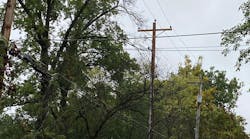From the desk of the president:
Utility vegetation management has never been more important, and the challenges faced by our industry today have never been greater. Climate change, introduced pests and more frequent and more intense storms are stressing trees and increasing failure rates. Utilities and contractors are struggling to find workers in a difficult labor market. Shipments of equipment and parts are delayed and costs are soaring. Yet the demand for reliable electric service continues unabated.
Considering these challenges, it follows that available resources should be leveraged to the greatest extent possible. Today, vegetation managers have more options than ever before to ensure that dollars are spent wisely. However, choosing the right combination of tools and methods can either make or break the effectiveness of a vegetation management program.
Leveraging More per Dollar Spent
Electric utilities spend about $10 billion annually on vegetation management in North America. This sounds like a lot of money, and it is; however, this figure represents just a small fraction of all utility revenue. While it is not possible to directly measure the value of this spend, we know that the cost of service interruptions due to vegetation has been estimated to be in excess of $100 billion annually. Without the efforts of our industry, this figure would surely be much higher. So it can be argued that this investment is sound; in fact, considering the high cost of interruptions, more could justifiably be invested in vegetation management.
However, before we start throwing more money at the problem, it makes sense to look carefully at our current operations and ask whether utilities (and the ratepayers we all work for) are receiving the best value for the dollars spent.
We can start by considering what causes most distribution vegetation-related service interruptions. It is well-established that regrowth from cleared trees poses relatively little risk; in fact, most damage comes from large trees and branches falling in from outside of specified clearance areas. It follows that utilities should refocus their UVM efforts to reduce this risk, rather than simply obtaining clearance. What is holding them back?
The reason is that obtaining clearance, even though it often only marginally reduces risk, is relatively easy. Systematically reducing risk requires greater expertise, and more communication and cooperation with property owners and municipalities. Still, with billions of dollars being spent, it is in everyone’s interest to focus on pruning and removing trees and branches that have the greatest likelihood of damaging utility facilities.
I often ask our field personnel if their work has ever prevented a power outage. Invariably every hand goes up—and for each of these, thousands of dollars in repairs and downstream costs are saved. More difficult is the question of how often they are required to prune or remove branches and trees posing very low risk compared to high-risk situations, e.g. dead, and defective trees, that were present but outside of the work specification.
Improving Results with Professional Expertise
Utility arboriculture is a profession. Doing the jobs well requires skills and expertise. The industry has created credentials, training programs and publications that define how to identify and mitigate risk from trees. Many of our personnel are pursuing these credentials, but the industry needs to do more to improve work specification to ensure that this expertise is leveraged toward reducing risk to utility facilities.
A variety of remote sensing technologies are designed to help utilities better focus their vegetation management efforts, often with the promise of significant cost savings. These programs can identify problem areas, but there are limitations. Many critical defects in trees can only be identified by trained personnel who are present on the site. Furthermore, the fact that tree failures continue to be one of the most significant causes of service interruptions indicates that there is plenty of work to do—if we can successfully focus our efforts on the highest risk situations.
On the transmission side, with millions of acres of land under the lines and above the pipes, utilities have an enormous opportunity to demonstrate their commitment to environmental stewardship. By implementing integrated vegetation management (IVM) on these ROWs, habitat for a range of species, including birds and pollinators, can be enhanced, often at lower cost (and a lower carbon footprint) than conventional maintenance methods.
The challenges faced by the UVM industry today are difficult, but they can also be seen as opportunities to drive innovation and change in ways that will increase the value of our services. To be successful, we must be willing to use the standards, best practices and credentials available to us and to leverage the available resources toward mitigating the greatest amount of risk.
Geoff Kempter ([email protected]) is president of the Utility Arborist Association.


